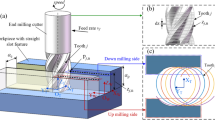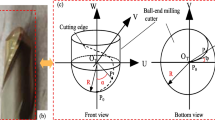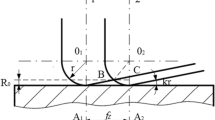Abstract
The machined surface topography of workpiece plays an important role in the performance and service life of workpiece. At present, the study of milling surface topography is mainly on 3-axis milling with ball end mill. Also, in 4/5-axis milling, surface topography analysis is mainly on the experimental data. In order to solve this problem, an analytical prediction model of milling surface topography is proposed, which can obtain the machined workpiece surface topography directly from cutting parameters, cutter location file, and workpiece surface geometry. The effects of cutting parameters on surface roughness are discussed, such as cutting velocity, feed speed, and lead angle. Different 4-axis milling experiment conditions are set up to validate the proposed model. The results show that the prediction results agree with experiment results. Also, this method can be used to predict the surface topography in five-axis milling and optimize the cutting parameters in the further.










Similar content being viewed by others
References
Zeng Q, Qin Y, Chang W (2018) Correlating and evaluating the functionality-related properties with surface texture parameters and specific characteristics of machined components. Int J Mech Sci 149:62–72
Arrazola PJ, Özel T, Umbrello D, Davies M, Jawahir IS (2013) Recent advances in modelling of metal machining processes. CIRP Ann Manuf Technol 62(2):695–718
Khorasani A, Yazdi MRS (2017) Development of a dynamic surface roughness monitoring system based on artificial neural networks (ANN) in milling operation. Int J Adv Manuf Technol 93:141–151
Liu C, Gao L, Wang G, Xu W (2020) Online reconstruction of surface topography along the entire cutting path in peripheral milling. Int J Mech Sci 185:105885
Ngerntong S, Butdee S (2021) Surface roughness and vibration analysis in end milling of annealed and hardened bearing steel. Measurement: Sensors 13:100035
Kong D, Zhu J, Duan C (2021) Surface roughness prediction using kernel locality preserving projection and Bayesian linear regression. Mech Syst Signal Process 152(2):107474
Cao L, Huang T, Zhang XM, Ding H (2021) Generative adversarial network for prediction of workpiece surface topography in machining stage. IEEE/ASME Transact Mechatron 26(1):480–490
Zhang WH, Tan G, Wan M, Gao T, Bassir DH (2008) A new algorithm for the numerical simulation of machined surface topography in multiaxis ball-end milling. J Manuf Sci Eng 130(1):011003
Peng Z, Jiao L, Pei Y, Yuan M, Gao S, Yi J (2018) Simulation and experimental study on 3D surface topography in micro-ball-end milling. Int J Adv Manuf Technol 96:1943–1958
Zhang X, Pan X, Wang G (2019) Influence factors of surface topography in micro-side milling. Int J Adv Manuf Technol 105:5239–5245
Arizmendi M, Jiménez A (2019) Modelling and analysis of surface topography generated in face milling operations. Int J Mech Sci 163:105061
Wang W, Li Q, Jiang Y (2020) A novel 3D surface topography prediction algorithm for complex ruled surface milling and partition process optimization. Int J Adv Manuf Technol 107:3817–3831
Xu J, Xu L, Geng Z, Sun Y, Tang K (2020) 3D surface topography simulation and experiments for ball-end NC milling considering dynamic federate. CIRP J Manuf Sci Technol 31:210–223
Wang, L., Ge, S., Si, H., Yuan, X., Duan, F. (2019). Roughness control method for five-axis flank milling based on the analysis of surface topography. Int J Mech Sci, 169:105337.
Torta M, Albertelli P, Monno M (2020) Surface morphology prediction model for milling operations. Int J Adv Manuf Technol 106:3189–3201
Duvedi RK, Bedi S, Batish A (2014) A multipoint method for 5-axis machining of triangulated surface models. Comput Aided Des 52:17–26
Kasima MS, Hafiz MSA, Ghani JA, Haron CHC, Izamshah R, Sundi SA, Mohamed SB, Othman IS (2019) Investigation of surface topology in ball nose end milling process of Inconel 718. Wear 426:1318–1326
Engin S, Altintas Y (2001) Mechanics and dynamics of general milling cutters: Part I: helical end mills. Int J Mach Tools Manuf 41:2195–2212
Zhou R (2020) Analytical model of milling forces prediction in five-axis milling process. Int J Adv Manuf Technol 108:3045–3054
Zhu R, Kapoor SG, DeVor RE (2001) Mechanistic modeling of the ball end milling process for five-axis machining of free-form surfaces. J Manuf Sci Eng 123(3):369–379
J. Carlton(2012) Marine propellers and propulsion. Butterworth-Heinemann.
Kupferinstitut D(2010) Recommended machining parameters for copper and copper alloys. German Copper Institute
Availability of data and material
All data generated or analyzed during this study are included in this published article.
Funding
This study is supported by the Hubei Superior and Distinctive Discipline Group of “Mechatronics and Automobiles” (XKQ2021037).
Author information
Authors and Affiliations
Contributions
Authorship specific contributions: Ruihu Zhou: methodology, writing—original draft preparation, Qilin Chen: experimental work. All authors have read and agreed to the published version of the manuscript.
Corresponding author
Ethics declarations
Ethical approval
Not applicable.
Consent to participate
Not applicable.
Consent to publication
Not applicable.
Conflict of interest
The authors declare no competing interests.
Additional information
Publisher’s note
Springer Nature remains neutral with regard to jurisdictional claims in published maps and institutional affiliations.
Rights and permissions
About this article
Cite this article
Zhou, R., Chen, Q. An analytical prediction model of surface topography generated in 4-axis milling process. Int J Adv Manuf Technol 115, 3289–3299 (2021). https://doi.org/10.1007/s00170-021-07410-x
Received:
Accepted:
Published:
Issue Date:
DOI: https://doi.org/10.1007/s00170-021-07410-x




